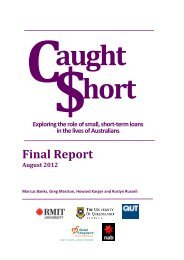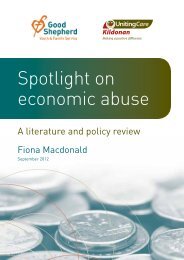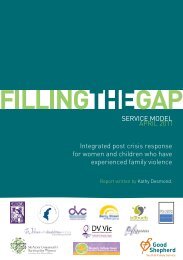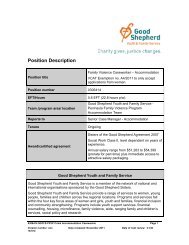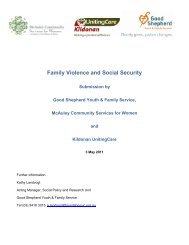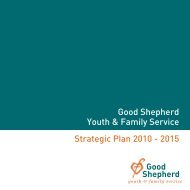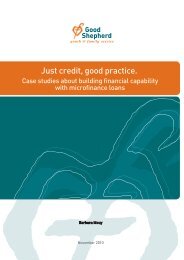Spotlight on economic abuse - Good Shepherd Youth & Family ...
Spotlight on economic abuse - Good Shepherd Youth & Family ...
Spotlight on economic abuse - Good Shepherd Youth & Family ...
Create successful ePaper yourself
Turn your PDF publications into a flip-book with our unique Google optimized e-Paper software.
Employment Frameworks, Policies and Practices<br />
In c<strong>on</strong>temporary public policy, participati<strong>on</strong> in employment is generally regarded as the<br />
primary means for women to gain ec<strong>on</strong>omic wellbeing while it has also been identified as a<br />
key pathway from domestic violence to ec<strong>on</strong>omic independence and self-sufficiency (Barrett<br />
Meyering 2010). Significant gender inequities exist for women when it comes to gaining<br />
ec<strong>on</strong>omic security through employment participati<strong>on</strong>. These include gender pay inequities<br />
and women’s over-representati<strong>on</strong> in low-paid and insecure employment, both of which are<br />
linked to broader social inequities. Gender segregati<strong>on</strong> in employment also services to<br />
reinforce traditi<strong>on</strong>al gender stereotypes. Reduced lifetime employment including because of<br />
pregnancy, childbirth and caring for children or other family members can also have negative<br />
impacts <strong>on</strong> overall financial security through employment and result in less accumulated<br />
superannuati<strong>on</strong> and fewer other savings for retirement (Cassells et al. 2009).<br />
Recent policy developments have seen some positive developments to address some of<br />
these broader gender inequities, including the introducti<strong>on</strong> of paid maternity leave and the<br />
success of a nati<strong>on</strong>al gender pay equity case for social and community services workers<br />
(Baird, Williams<strong>on</strong> & Her<strong>on</strong> 2012; McCrystal & Smith 2011). However, significant gender pay<br />
inequities c<strong>on</strong>tinue to exist—supported by women’s c<strong>on</strong>centrati<strong>on</strong> in particular occupati<strong>on</strong>s<br />
and industries—while problems associated with increased insecurity in employment c<strong>on</strong>tinue<br />
to disproporti<strong>on</strong>ately affect women, including because much part-time employment is casual<br />
employment. Casual employment, which is without paid leave entitlements, makes up a<br />
quarter of all women’s employment (ABS 2011).<br />
In Australia and elsewhere there has been some attenti<strong>on</strong> to workplaces as sites for<br />
addressing domestic and family violence through primary, sec<strong>on</strong>dary and tertiary<br />
interventi<strong>on</strong>s and all of these are also direct means of preventing or resp<strong>on</strong>ding to ec<strong>on</strong>omic<br />
<strong>abuse</strong>. In relati<strong>on</strong> to primary interventi<strong>on</strong>s, as outlined above, c<strong>on</strong>temporary domestic and<br />
family violence policies specifically identify employment participati<strong>on</strong> and equality in<br />
employment as preventative measures supporting women’s ec<strong>on</strong>omic independence. Other<br />
areas of public policy which impact <strong>on</strong> women’s workforce participati<strong>on</strong> are childcare,<br />
educati<strong>on</strong> and training, employment assistance and income support, and these are also<br />
important tertiary interventi<strong>on</strong>s for women who have experienced domestic and family<br />
violence.<br />
Sec<strong>on</strong>dary interventi<strong>on</strong>s prevent discriminati<strong>on</strong> against women who have been subjected to<br />
violence, use the workplace as a site for women to gain access to support and informati<strong>on</strong><br />
and make workplaces safe and supportive for women who have been subjected to domestic<br />
and family violence. Relevant regulati<strong>on</strong> in additi<strong>on</strong> to employment regulati<strong>on</strong> includes antidiscriminati<strong>on</strong><br />
and workplace health and safety, and strategies include educati<strong>on</strong> and<br />
training for employers and employees about domestic and family violence.<br />
Tertiary interventi<strong>on</strong>s resp<strong>on</strong>d to violence through provisi<strong>on</strong> of assistance and employee<br />
entitlements such as paid leave for women who have been subjected to domestic and family<br />
violence. In additi<strong>on</strong> to workplace relati<strong>on</strong>s legislati<strong>on</strong> and industrial instruments (for<br />
example, collective enterprise agreements and awards) anti-discriminati<strong>on</strong> legislati<strong>on</strong> is<br />
relevant here. The other significant area of tertiary interventi<strong>on</strong> is the facilitati<strong>on</strong> of<br />
participati<strong>on</strong> in employment by women who have been subjected to domestic and family<br />
violence including through individual job search, training and other employment assistance.<br />
There is little published research relating to effective resp<strong>on</strong>ses in this area and it could be<br />
the focus of further investigati<strong>on</strong>. Past Comm<strong>on</strong>wealth employment programs specifically<br />
targeted to assist sole parents including the Jobs Educati<strong>on</strong> and Training program are<br />
49





